Commercial Janitorial Equipment Market Research, 2031
The global commercial janitorial equipment market size was valued at $5.7 billion in 2021, and is projected to reach $8.9 billion by 2031, growing at a CAGR of 4.6% from 2022 to 2031.
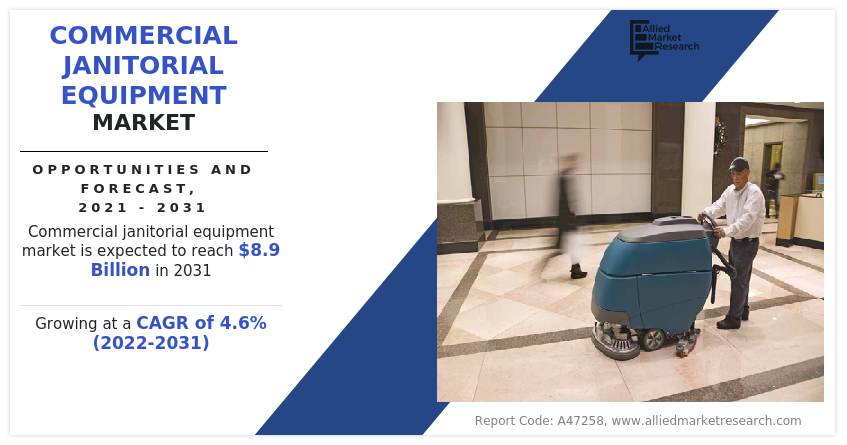
The commercial janitorial equipment market is segmented into Type, End User and Distribution Channel.
Commercial janitorial equipment includes floor scrubbers, tile and grout cleaners, vacuum cleaners, carpet cleaners, duct cleaners, air blowers, escalator cleaners, and other janitorial equipment. This equipment is used in the commercial building by janitorial services providers. Commercial janitorial equipment is widely used by janitorial service providers to maintain cleanliness and hygiene. It is widely used in different end-use industries such as HoReCa (hotels, restaurants, and catering), government institutes, shopping centers, corporate centers, hospitals and research laboratories, convection centers, and other end-use industries. With the increase in the adoption of automated janitorial equipment, the demand for commercial janitorial equipment is increasing day by day in developing and developed countries. There are different types of automated janitorial equipment offered by manufacturers operating in the market.
There has been a surge in the number of restaurants, hotels, and hospitals across the globe, which further contribute to the demand for various commercial cleaning equipment such as floor scrubbers, tile and grout cleaners, vacuum cleaner, carpet cleaner, and air blowers to maintain a clean and hygienic environment in the spaces. This factor is expected to drive the growth of the commercial janitorial equipment market in the upcoming years. The increase in women’s working-class population in various countries such as India, China, and Brazil along with the surge in urbanization is further anticipated to boost the growth of the commercial janitorial equipment market. In addition, the changing consumer lifestyle and increasing income levels are also expected to drive the growth of the market. Furthermore, the higher prominence towards cleanliness and hygiene and renting of commercial cleaning equipment rather than purchasing is also predicted to boost the growth of the commercial janitorial equipment industry.
The increase in the shift towards connected and intelligent machines which are automated and efficient is driving the growth of the commercial janitorial equipment market. Furthermore, the increase in the adoption of automated janitorial equipment is expected to result in the growth of the commercial janitorial equipment market. For instance, intelligent generators in ultrasonic cleaning, which can configure, monitor, and optimize their operation, are gaining popularity among consumers. Thus, the incorporation of sophisticated technologies for continuous in-line monitoring and adjustments is a common feature offered by manufacturers of automated janitorial equipment. Further, the increase in popularity of smart manufacturing, big data, and the Internet of Things is expected to result in improved cleaning efficiency. This factor is expected to boost the growth of the commercial janitorial equipment industry.
Economic growth is leading to the development of infrastructure and a rise in building activities, which is expected to drive the growth of the global commercial janitorial equipment market. An increase in the number of buildings and the need to keep office spaces clean is anticipated to drive the demand for janitorial services and supplies. In addition, a rise in the construction of residential properties globally due to various macro-level factors, such as rapid urbanization, government subsidies, interest rates, and others is expected to boost the commercial janitorial equipment market in the upcoming years.
With the improvement in economic conditions, consumers in developing as well as developed countries are inclining towards smart and automated janitorial equipment which is a key factor that contributes to the growth of the market. An increase in per capita disposable income enhances the spending capacity of consumers, leading to a rise in expenditure on innovation and automation, which is expected to drive the global commercial janitorial equipment market growth. The rise in spending capacity is further anticipated to improve the standard of living, enabling janitorial service providers to buy high-quality, automated equipment, which, in turn, boosts the demand for commercial janitorial equipment. In addition, the high adoption of automated janitorial equipment in developing regions, including Asia-Pacific and LAMEA further drives the growth of the global commercial janitorial equipment market.
E-commerce is gaining significant popularity and is being used frequently to sell and buy products. The proliferation of smartphones and the growing usage of social media attract janitorial equipment manufacturers and advertising media companies to promote and spread awareness about their products on social media. A large number of consumers, especially the youth population, are active on social media platforms. Social media, including Facebook and Instagram, are very popular among young consumers. Thus, brands are using these social media platforms to build advertising campaigns for promotion and provide products through online platforms, including Amazon, Flipkart, YourFit, and their own retail websites and applications. Moreover, janitorial equipment companies are promoting their products through celebrity endorsement that encourages young consumers to buy newly launched janitorial equipment. This, in turn, drives the growth of the global janitorial equipment market.
The high price of commercial janitorial equipment is expected to be a demerit for the commercial janitorial equipment market. The cost of automated and semi-automated janitorial equipment is higher than traditional janitorial equipment. With the increase in demand for automated janitorial equipment owing to its efficiency and unique features, consumers in developed countries such as the U.S., Germany, and others are inclined towards automated janitorial equipment. In developing countries such as India, China, Brazil, Chile, and others, commercial janitorial service providers use manual workforce over automated equipment owing to the higher cost of automated and semi-automated janitorial equipment and the availability of low-cost manual workforce. Therefore, these factors are expected to hinder the growth of the market during the forecast period.
According to the market analysis, the commercial janitorial equipment market is segmented into type, end user, distribution channel, and region. By type, the market is divided into floor scrubbers, tile and grout cleaners, vacuum cleaners, carpet cleaners, duct cleaners, air blowers, escalator cleaners, and others. By end user, the market is divided into HoReCa, government institutes, shopping centers, corporates centers, hospitals and research laboratories, convention centers, and others. By distribution channel, the market is divided into B2B, third party distribution, e-commerce, and others. Region-wise, the market is analyzed across North America (the U.S., Canada, and Mexico), Europe (Germany, France, Italy, Spain, UK, Russia, and rest of Europe), Asia-Pacific (China, Japan, India, South Korea, Australia, Thailand, Malaysia, Indonesia, and rest of Asia-Pacific), and LAMEA (Brazil, South Africa, Saudi Arabia, UAE, Turkey, Argentina, and rest of LAMEA).
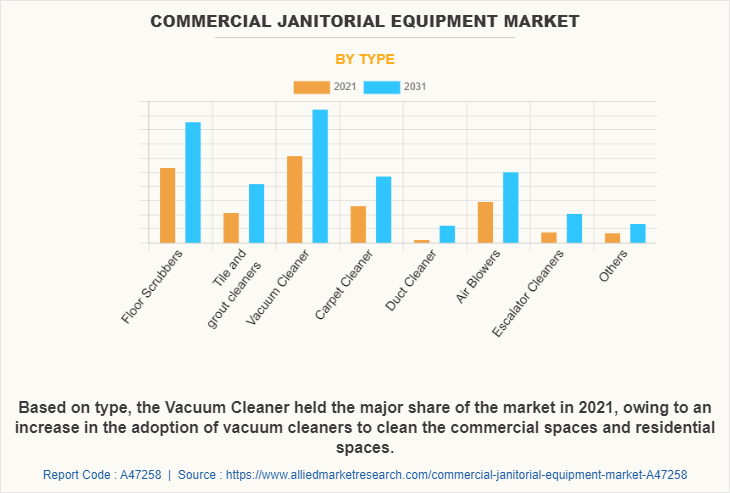
On the basis of type, the vacuum cleaner segment accounted for the major share of the market in 2021, owing to an increase in the adoption of vacuum cleaners by janitorial service providers to clean commercial spaces and residential spaces. The commercial vacuum cleaner market is expanding as end-user industries are increasingly concerned about sanitation, health, and safety. Vacuum cleaners are widely used in commercial spaces for cleaning, and it helps to clean the spaces in less time with a low workforce, which is expected to drive the growth of the market. With continuous technological developments, semi-automatic and automatic vacuum cleaners have gained increasing traction over manual machines, vacuum cleaners have extensive applications across various commercial spaces such as government institutes, shopping centers, corporate centers, hospitals and research laboratories, convention centers, and event venues.
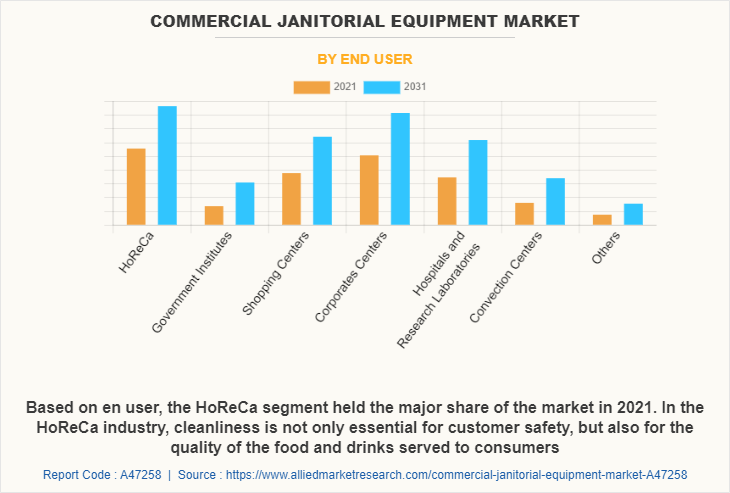
On the basis of end user, the HoReCa segment accounted for more than 20% of the commercial janitorial equipment market share in 2021. In the HoReCa industry, cleanliness is not only essential for customer safety, but also for the quality of the food and drinks served to consumers. With the rise in the adoption of automated janitorial equipment over traditional equipment, consumers are inclined toward automated cleaning equipment which is expected to drive the growth of the market. the rising adoption of different types of janitorial equipment from HoReCa is expected to boost the commercial janitorial equipment market demand. Automated janitorial equipment is more popular among consumers owing to its advantages such as it requires less time and less manpower.
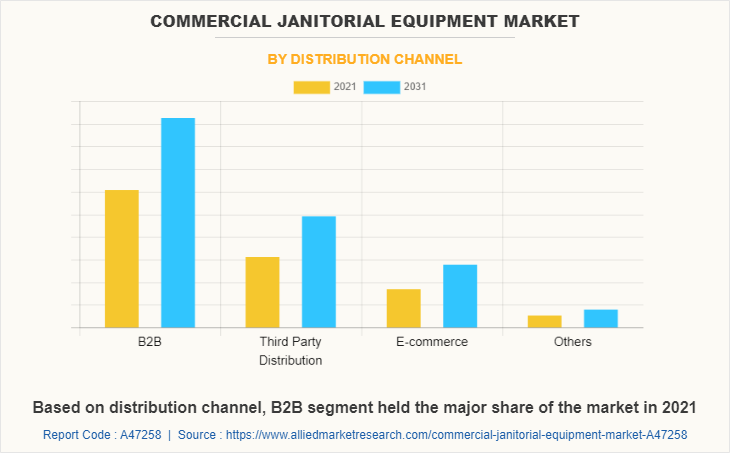
On the basis of distribution channel, the global commercial janitorial equipment market is categorized into B2B, third-party distribution, e-commerce, and others. The B2B segment dominated the commercial janitorial equipment market and accounted for 53.3% of the market share in 2021 and is expected to maintain its dominance during the forecast period. Manufacturers are continuously making efforts to increase the shelf visibility of their products; hence, they are majorly targeting specialty stores. Therefore, a variety of commercial janitorial equipment is available in specialty stores. Moreover, specialty stores provide options, such as discounts as well as benefits of immediate gratification, which result in the growth of the commercial janitorial equipment market.
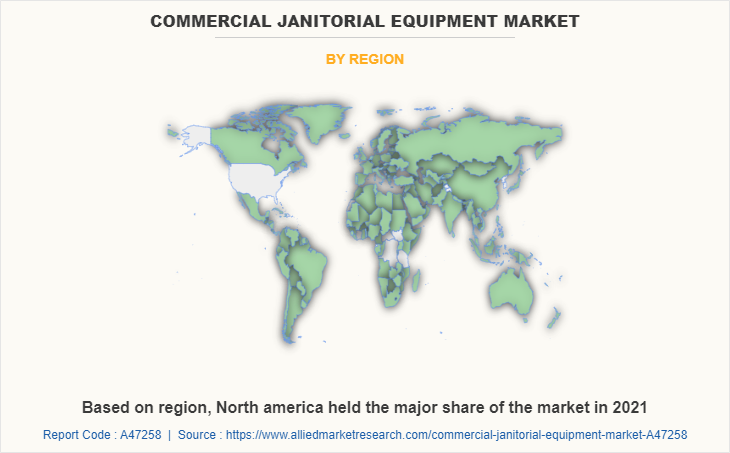
Region-wise, North America accounted for the highest market share of 32.6% in 2021. North America is the major market for commercial janitorial equipment. The North America commercial janitorial equipment market is analyzed across the U.S., Canada, and Mexico. An increase in the adoption of innovative and technically advanced janitorial equipment by the end user to maintain cleanness and hygiene is expected to boost the North America commercial janitorial equipment market. This increasing trend is compelling manufacturers to develop technologically advanced janitorial equipment that can be cost-efficient and innovative. Moreover, high work efficiency is the need of the hour hence, janitorial equipment that cleans maximum space in less time is expected to contribute toward the growth of the commercial janitorial equipment market forecast.
The players in the commercial janitorial equipment market have adopted acquisition, business expansion, partnership, collaboration, and product launch as their key development strategies to increase profitability and improve their position in the commercial janitorial equipment market.
Some of the key players profiled in the commercial janitorial equipment market analysis include Amano Corporation, Ashbys Cleaning Equipment, Bayersan Ltd, Betco, Boss Cleaning Equipment Company, Charnock Equipments Pvt. Ltd., Comac, Diversey Inc., DULEVO INTERNATIONAL S.P.A., Hako GmbH, Jon-Don, LLC, Kärcher, Roots Multiclean LTD, Tennant Company, and TRUVOX
Key Benefits For Stakeholders
- This report provides a quantitative analysis of the market segments, current trends, estimations, and dynamics of the commercial janitorial equipment market analysis from 2021 to 2031 to identify the prevailing commercial janitorial equipment market opportunities.
- The market research is offered along with information related to key drivers, restraints, and opportunities.
- Porter's five forces analysis highlights the potency of buyers and suppliers to enable stakeholders make profit-oriented business decisions and strengthen their supplier-buyer network.
- In-depth analysis of the commercial janitorial equipment market segmentation assists to determine the prevailing market opportunities.
- Major countries in each region are mapped according to their revenue contribution to the global market.
- Market player positioning facilitates benchmarking and provides a clear understanding of the present position of the market players.
- The report includes the analysis of the regional as well as global commercial janitorial equipment market trends, key players, market segments, application areas, and market growth strategies.
Commercial Janitorial Equipment Market Report Highlights
| Aspects | Details |
| Market Size By 2031 | USD 8.9 billion |
| Growth Rate | CAGR of 4.6% |
| Forecast period | 2021 - 2031 |
| Report Pages | 300 |
| By Type |
|
| By End User |
|
| By Distribution Channel |
|
| By Region |
|
| Key Market Players | Charnock Equipments Pvt. Ltd., Ashbys Cleaning Equipment, Hako GmbH, Diversey Holdings, LTD., Tennant Company, BOSS Cleaning Equipment, Amano Corporation, Alfred Karcher SE & Co. KG, Roots Multiclean Ltd., Jon-Don, LLC, COMAC India Private Limited, Bayersan Cleaning Products, Truvox International Limited, Dulevo International S.P.A., Betco |
Analyst Review
According to the insights of CXOs of leading companies, the janitorial equipment market holds a substantial scope for growth. There has been a surge in the number of restaurants, hotels, and hospitals across the globe, which further contribute to the demand for various commercial cleaning equipment such as floor scrubbers, tile and grout cleaners, vacuum cleaner, carpet cleaner, and air blowers to maintain a clean and hygienic environment in the spaces. This factor is expected to propel the growth of the commercial janitorial equipment market in the upcoming years. However, its contribution to the world market would increase significantly within the next six years. Moreover, the increase in investment in the R&D of janitorial equipment by key manufacturers is expected to create opportunities in the market in the upcoming years.
The CXOs further added that the shopping behavior of the millennial generation and the emergence of mobile devices for Internet access are expected to boost market growth. The increase in penetration of e-commerce shopping portals in developing economies such as India, Brazil, and Chile, among others is expected to boost the growth of the market. Therefore, the e-commerce medium for the sale of janitorial equipment is anticipated to grow in the future.
The global commercial janitorial equipment market size was valued at $5,698.0 million in 2021 and is projected to reach $8,855.8 million by 2031, registering a CAGR of 4.6% from 2022 to 2031.
According to the market analysis, the global commercial janitorial equipment market is segmented into type, end user, distribution channel, and region. By type, the market is divided into floor scrubbers, tile and grout cleaners, vacuum cleaners, carpet cleaners, duct cleaners, air blowers, escalator cleaners, and others. Based on end user, the market is divided into HoReCa, government institutes, shopping centers, corporates centers, hospitals and research laboratories, convection centers, and others. By distribution channel, the market is divided into B2B, third party distribution, e-commerce, and others. Region-wise, the market is analyzed across North America (the U.S., Canada, and Mexico), Europe (Germany, France, Italy, Spain, UK, Russia, and rest of Europe), Asia-Pacific (China, Japan, India, South Korea, Australia, Thailand, Malaysia, Indonesia, and rest of Asia-Pacific), and LAMEA (Brazil, South Africa, Saudi Arabia, UAE, Turkey, Argentina, and rest of LAMEA).
The major players analyzed for the commercial janitorial equipment market are Amano Corporation, Ashbys Cleaning Equipment, Bayersan Ltd, Betco, Boss Cleaning Equipment Company, Charnock Equipments Pvt. Ltd., Comac, Diversey Inc., DULEVO INTERNATIONAL S.P.A., Hako GmbH, Jon-Don, LLC, Kärcher, Roots Multiclean LTD, Tennant Company, and TRUVOX.
The global commercial janitorial equipment market report is available on request on the website of Allied Market Research
The forecast period considered in the global commercial janitorial equipment market report is from 2022 to 2031. The report analyzes the market sizes from 2022 to 2031 along with the upcoming market trends and opportunities. The report also covers the key strategies adopted by the key players operating in the market.
Loading Table Of Content...


